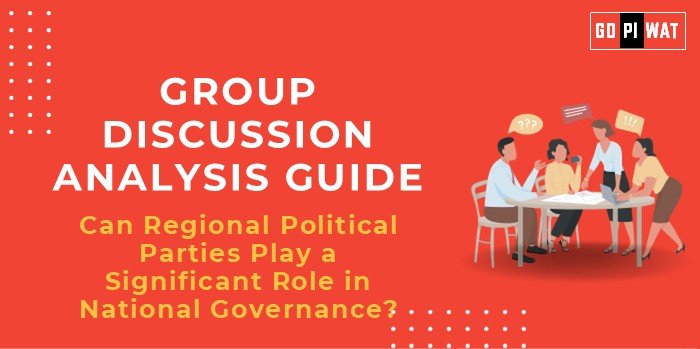📋 Group Discussion Analysis Guide: Can Regional Political Parties Play a Significant Role in National Governance?
🌐 Introduction to Regional Political Parties in India
India’s political landscape is characterized by a vibrant multi-party system, where regional political parties have emerged as significant players in shaping both state and national policies.
Topic Background: The rise of regional parties began in the late 20th century, reflecting the country’s diverse cultural and linguistic demographics. Their influence has grown, especially in coalition governments, impacting national governance.
📊 Quick Facts and Key Statistics
- Recognized Regional Parties: As of May 2023, India had over 50 state parties and more than 2,000 unrecognized parties.
- Coalition Governments: Since 1989, India has witnessed multiple coalition governments, highlighting the necessity of regional parties in forming central governments.
- Vote Share: In the 2019 General Elections, regional parties collectively secured a significant portion of the vote share, underscoring their electoral importance.
- State Governance: Several Indian states are governed by regional parties, emphasizing their control over local governance.
🏛️ Stakeholders and Their Roles
- Regional Political Parties: Advocate for local issues, represent regional identities, and influence national policies through coalition partnerships.
- National Political Parties: Collaborate with regional parties to form governments, ensuring representation of diverse regional interests.
- Voters: Elect representatives who address local and national concerns, influencing the political landscape.
- State Governments: Implement policies shaped by both regional and national political dynamics.
✅ Achievements and Challenges
🏆 Achievements:
- Enhanced Representation: Regional parties ensure that local issues and identities are represented at the national level.
- Policy Innovation: They have introduced region-specific policies that have been adopted nationally, such as certain welfare schemes.
- Strengthening Federalism: Their presence has reinforced India’s federal structure by advocating for state autonomy.
⚠️ Challenges:
- Policy Fragmentation: Diverse regional interests can lead to fragmented national policies.
- Coalition Instability: Coalition governments may face instability due to differing regional party agendas.
- Resource Allocation Conflicts: Competing regional demands can complicate equitable resource distribution.
🌏 Global Comparisons:
- Germany: Regional parties play a crucial role in coalition governments, similar to India’s political dynamics.
- Canada: Provincial parties influence federal policies, reflecting regional interests.
📚 Case Studies:
- Tamil Nadu: The Dravida Munnetra Kazhagam (DMK) has significantly influenced both state and national politics through coalition participation.
- West Bengal: The All India Trinamool Congress (AITC) has impacted national policies by leveraging its regional strength.
🗣️ Structured Arguments for Discussion
- Supporting Stance: “Regional parties are essential for representing India’s diverse population, ensuring that local issues are addressed at the national level.”
- Opposing Stance: “The proliferation of regional parties can lead to fragmented governance and policy paralysis at the national level.”
- Balanced Perspective: “While regional parties enhance representation, their influence must be balanced to maintain national unity and effective governance.”
📋 Effective Discussion Approaches
- Opening Approaches:
- Statistical Insight: “With over 50 recognized state parties, regional political entities play a pivotal role in India’s democracy.”
- Historical Context: “Since the late 20th century, regional parties have transformed India’s political landscape, influencing both state and national governance.”
- Counter-Argument Handling:
- Acknowledge Valid Points: “While it’s true that regional parties can lead to coalition complexities, they also ensure that diverse voices are heard in governance.”
- Provide Solutions: “Establishing clear coalition frameworks can mitigate the challenges posed by multiple regional parties.”
🧩 Strategic Analysis of Strengths and Weaknesses
Strengths:
- Diverse Representation: Ensures that various regional interests are considered in national policies.
- Policy Innovation: Introduces innovative policies tailored to regional needs.
Weaknesses:
- Governance Instability: Coalition governments may face challenges due to differing agendas.
- Resource Allocation Issues: Conflicting regional demands can complicate national resource distribution.
Opportunities:
- Strengthening Federalism: Promotes a more balanced federal structure by advocating for state rights.
- Collaborative Governance: Encourages collaboration between national and regional parties for holistic development.
Threats:
- National Fragmentation: Excessive regionalism may threaten national unity.
- Policy Paralysis: Divergent regional interests can lead to delays in policy implementation.
🔗 Connecting with B-School Applications
- Real-World Applications: Understanding the dynamics between regional and national parties is crucial for roles in public policy, governance consulting, and political risk analysis.
- Sample Interview Questions:
- “How do regional parties influence economic policies at the national level?”
- “Discuss the challenges and benefits of coalition governments in India.”
- Insights for B-School Students:
- Analyzing the role of regional parties can provide insights into managing diverse teams and interests in corporate settings.
- Understanding coalition dynamics is beneficial for strategic decision-making in complex organizational structures.


